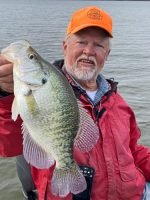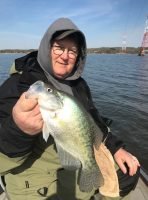Winter crappie often school together, occupying deeper structure in hot pursuit of shad
residing there to avoid quick surface temp changes. Tightlining jigs and minnows around
deep cover will pay dividends but best to move the bait around slowly, avoiding the
yo-yoing movement. (Photo: Steve McCadams)
Warm Up Inside and Out with Winter Crappie
by Steve McCadams
Appearing now at a lake near you. Hot spots out in the middle of open water where submerged structure clinging to the deep side of a ledge holds buried treasures.
Despite a chill in the air, while you are wrapped up like a Christmas gift, there’s nothing like the light strikes from a heavy crappie that sort of feels like pulling up a Volkswagen from the brawny deep.

Within seconds the heart starts pumping, warming you up quicker than a sun swept beach in the Bahamas. Better than soft sand between your toes, a silver slab crappie is fighting to stay deep.
Grabbing the net, while hoping the knot and line hold true, reveals a barely hooked jig just waiting on the slightest slack to loosen its feeble grip. Luck stays with you as the net pushed up under the fish, coming up with the trophy.
Once in the boat you pause in admiration of the silver slab, thanking the Big Fisherman in the sky for bringing you and this piscatorial king together.
Winter? What winter?
You’ve discovered the cure to the winter blues – back-to-back crappie putting a bend in your rod. Finesse fishing has enabled you to fine tune your presentation, navigating your jig or live minnow rigs slowly in and around structure.
Knowing when not to jerk is just as important as knowing when to pull the trigger. Premature hook sets result in a tug of war with stubborn limbs. Occasionally you’ll win a battle but in the long run you lose the war.
Easing the bait presentation in and around the snags works best. Resist the temptation to yo-yo the bait. Too much movement can actually repel cold water crappie. A soft and slow touch with maybe with a light twitch of the rod’s tip now and then will suffice.
Deep water crappie love brushpiles, stakebeds, natural snags and stumps. Deep is a relative term but on large reservoirs a depth range of 15 to 25 feet is common. In clear lakes maybe even deeper.
Following their forage base on a path to deeper depths are schools of crappie during winter months. Shad, especially threadfin, are the morsels of choice and the little silver delights have one problem with rapidly falling surface temperatures; they don’t like it!
Shad kills often occur when quick drops in surface temperature catch them in shallow water. Lulled by warm sunny days into bays and pockets off the main lake have them congregated in shallow venues.
In summary the shad seek deeper depths as winter rolls around. It gives them a better comfort zone. Deeper depths don’t change temps quickly so shad can ride it out there better.
Crappie capitalize on the habits of their prey, staying right with them as they meander around structure along deep sloughs, edges of creek channels, drop-offs, ledges, humps and the like.
Find cover on the deep side of the ledge and you will likely find fish.
Sonar units have never been more useful than in the pursuit of winter crappie. Mastering the screen’s revealing features of depth, structure and baitfish location is over half the battle.
Color choices and size of the jig skirt are active ingredients in the recipe for success as well.
ATTRACTANTS
Tipping jigs with scent attractants such as Berkley Power Bait crappie nibbles enhance bites too from finicky crappie. Don’t be afraid to experiment during your quest.

FORWARD-FACING SONAR (FFS)
Today’s forward-facing sonar units have taken it to another level, allowing savvy sonar slab seekers to pinpoint the whereabouts of fish within the structure. It’s impressive technology in the hands of the right person.
TRUST YOUR GUT
Experience and common sense still have a time and place. Remember: you are the student; the lake and crappie are the teachers.
DON’T OVERLOOK THE BASICS
Understanding the basic habits of winter crappie to occupy deep structure in main lake areas will put you in touch with the fish.
That’s assuming you’ve mastered interpretation of basic sonar screen adjustments while making sure your unit’s transducer is mounted properly and in working order.
Without good sonar equipment you’ll be a lost ball in high weeds when it comes to finding and catching winter crappie on most lakes.
Weather and wind are always high hurdles for open water winter expeditions. Time has changed technology; it hasn’t diminished battling the elements of Mother Nature.
USE YOUR OWN STRUCTURE
While you can’t control weather you can help decide your destiny for winter crappie by devoting time and efforts to sinking lots of manmade fish attractors (But check your local regulations.). Target those deeper zones on the sides of river channels, creek bends, humps, etc.
Give the crappie a reason to hang out in specific spots. Play the wind. Place out structure in areas that might be shielded, at least to some degree, from nasty northeast winds.
Such efforts, when combined with honing your sonar skills and fishing experience, will bring you and winter crappie closer together.
When you hear fish slapping the top of the cooler lid jockeying for position or splashing about in the livewell competing for space, you’ll forget bone chilling winds slapping at your neck.
Seeing winter slabs appear after a tug of war battle will indeed warm your heart. Even on the coldest day, you’ll be warm from the inside out!
Winter? What winter?
Steve McCadams is a professional guide and outdoor writer from Paris, TN. At 70 years old, he’s been living and writing about the outdoors pretty much all this life. He holds a B.S. Degree in biology and has been Inducted into the National Freshwater Fishing Hall of Fame and Legends of the Outdoors. He shares a home with his wife Linda and their Labrador retriever, Avery.


